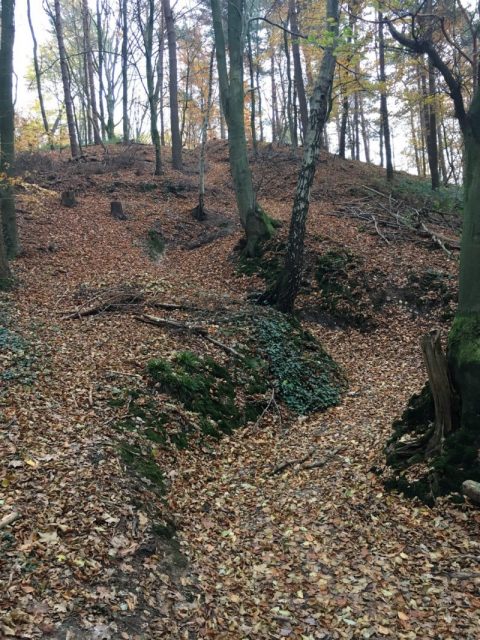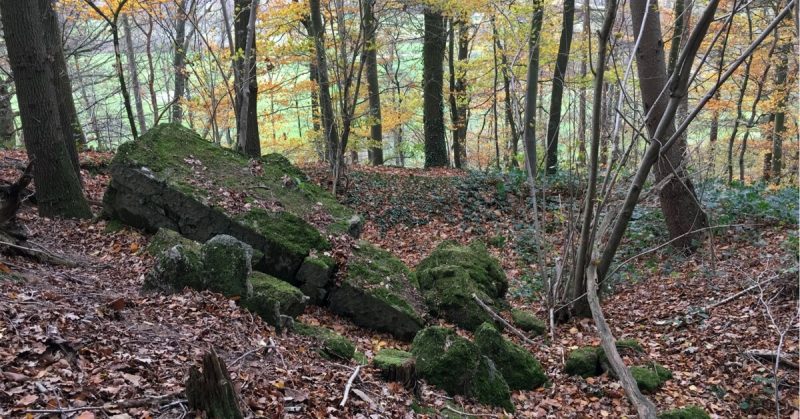Earlier this month The Battlefield Explorer visited the western edge of the Reichswald forest, called Pyramid hill to look at the German trenches and remains of bunkers which have survived to this day. To tell the story of what happened on that particular hill we have to zoom out first and look at the big picture.
The Westwall in the Reichswald
The Reichswald is a forest on the border of Germany and the Netherlands. When the Germans built their Westwall or Siegfried line, the Reichswald was the most northernly endpoint. The forest is 14 kilometers long and 8 km wide and is wedged between the Rhine River to the north and Meuse to the south.
Construction of a limited number of concrete bunkers and a lot of earthworks such as trenches and mortar pits started in the late 1930s. This section of the line was occupied until May 10, 1940, when the Germans invaded the Netherlands. Having conquered the Netherlands, Belgium, and France, the borders of the Greater German Reich moved to the Atlantic coast, which caused the Westwall to be abandoned. Over the next four years, it was used only as a depot for materials which the Germans would need to build a new Atlantic Wall.
Operation Market Garden
Then in late August and early September 1944, in one summer, the Germans were pushed back to their frontiers, and the neglected Westwall suddenly became of enormous importance again. The allies feared the defensive line which had been hyped in German propaganda in the late 1930s. It led directly to Operation Market Garden, which had the objective of outflanking it to allow the allies a direct route to Berlin.
On September 17, 1944, two regiments of the 82nd Airborne landed mere kilometers from the Reichswald which then became the front line. Allied intelligence had obtained information that the Germans were hiding 1,000 tanks in the woods making it a prime objective of the Americans to secure that flank.
It turned out that the Reichswald was unsuitable for tanks and only a fraction of the alleged 1,000 tanks ever materialized. It was, however, a perfect staging area for the Germans from which to launch counter-attacks that caused the 82nd Airborne a lot of trouble. After Operation Market Garden had failed a stalemate followed, and both sides dug in for the winter. For months the fighting was limited to combat patrols and artillery duels as the focus shifted elsewhere.

Operation Veritable
However, the British Field Marshal Montgomery kept his eye on that bit of land and as early as October 1944 planning began for a new offensive through the Reichswald. Originally scheduled to start on January 1, the German attack in the Ardennes, the Battle of the Bulge, caused the start date to be pushed back to February 8, 1945. The Germans used the time well and constructed elaborate earthworks, trenches, and anti-tank ditches.
Early on the morning of February 8, the Allies artillery opened up, and thousands upon thousands of shells were fired on the German positions. General Crerar, the Commander of the 1st Canadian Army, planned to blast a path through the German defenses. The 2nd and 3rd infantry division, as well as the 15th Scottish, 51st Highland and 53rd Welsh divisions from the attached XXXX corps, would then attack. Facing them was the German 84th infantry division, consisting of 10,000 inexperienced, poorly trained and poorly equipped soldiers.
Pyramid Hill
At the last-minute, the 84th was reinforced by 2,000 well-equipped paratroopers who took over the area from the western edge of the Reichswald to the Meuse river. They defended a piece of terrain called Pyramid hill which was the objective of the 5th Black Watch, 153rd Brigade.
At 10:30HRS the infantry attack started and slowly but surely the Allies pushed the Germans back into the forest. After a day of heavy fighting, the Black Watch had reached the top of Pyramid hill by midnight and had enabled the 1st Gordons to continue the attack westwards.
Today
Having visited Pyramid hill a couple of times over the past years, I realized I never looked further than a tiny section right on the border. It was high time I changed this so armed with my camera and a couple of spare batteries I crossed the border into Germany, off to find concrete and trenches.
Don’t miss any of my videos by subscribing today!
Join me on my trips, visit the known and unknown battlefields, uncover hidden artifacts that are still out there, experience amazing war history events, and pay tribute at commemorations. It will be the adventure of a lifetime, and you will be in the front row to experience it with me.
